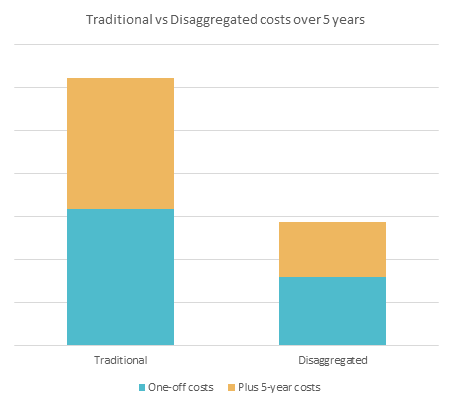How to halve the cost of your telco network

As we’ve engaged with telcos planning to disaggregate their networks, we’ve learnt a lot about how they can reduce their costs. Our TCO (Total Cost of Ownership) models show that a disaggregated IP/MPLS network costs less than half that of a traditional network. These results help explain why network disaggregation is probably the most important shift to arrive in telco networks since the arrival of the Internet. It’s important to state that our TCO model is just that – a model. Although all the data is based on real network inputs, so we will be transparent about our underlying assumptions.
Results
TCO for our disaggregated network is 52% less than that of a network built from traditional chasis-based routing systems from established vendors.
Savings | |
One-off capex costs | 50% |
5-year opex cost | 57% |
Total Cost of Ownership | 52% |
Significant cost savings are achieved from both the one-off purchase and 5-year operating costs of the network, with a slightly higher percentage reduction in opex costs.

TCO Scope
We’ve compared a network built from traditional IP/MPLS routers and one built with disaggregated bare-metal switches and RtBrick software. Our model is based on a large-scale fixed access network driven by consumer broadband traffic, although we also expect the model’s conclusions to be broadly applicable to other carrier routing use-cases. The model includes several different areas of cost, calculated over a 5-year period:
- Capex purchase costs of hardware and software licenses
- Operational maintenance and support costs
- Power consumption
We’ll also look at some more important considerations later, that are not included in these calculations.
Assumptions and Sensitivities
There are more details available on sensitivities in our TCO whitepaper. A summary of these include:
- Size of network: savings are based on one million subscribers, but increasing this number makes little difference beyond the ability to negotiate greater discounts
- Density of subscribers: a higher density of subscribers connected to each PoP increases savings even further
- Bandwidth Per Subscriber: savings increase once peak bandwidth exceeds 24Mbps – up until that point they remain flat
- List Pricing and Vendor Discounts: we’ve assumed traditional equipment can be purchased at 85% discount, and disaggregated hardware and software at 35%. Varying these discounts within a reasonable range can increase savings beyond 60%
The TCO whitepaper includes more input data and assumptions.
Disaggregated Platform Choice
The TCO model assumes the use of bare-metal switches for the routing hardware. However, it is possible to use x86 based servers with NIC cards to achieve the same functionality (in fact, RtBrick’s own software also runs on x86 servers, as well as bare-metal-switches). The difference in capital cost of the hardware is not that material, but the power consumption costs of x86 processors are significantly higher, resulting in the erosion of all savings compared to traditional systems, and 5-year costs actually being slightly higher.
Additional Factors
There are a number of other factors that would affect any real-world case that we didn’t include, due to the difficulty in quantifying them or applying them to a model, or the lack of data. Most would improve the case for disaggregated networks even further.
The one obvious downside is the cost of change. In practice there would be one-off project costs, retraining and adoption of new working practices. These are hard costs to quantify but most telcos are already committed to adopting these new practices as part of NFV (Network Functions Virtualization) or other cloud initiatives.
There are several upsides that haven’t been included in these calculations:
- Significant operational savings become possible due to standardizing on a single OS (e.g. Linux Ubuntu) across all services and platforms
- Procurement leverage over suppliers will increase as software and hardware can be purchased independently, driving down costs further
- This comparison has been based on static traffic levels and number of subscribers. In practice growth in either dimension will further benefit the case for disaggregated networks.
More than just lower TCO…
Lower TCO is clearly an important benefit of network disaggregation, but bringing this cloud-native approach to your carrier network brings many other benefits, arguably even more important than the lower costs:
- Control over you own destiny – like any cloud-native, this highly adaptable approach allows you to break free from the service features and timescales imposed by networking vendors, and deploy the services you want, whenever you want them
- Flexibility - you break the hard-wiring between platforms and services, enabling re-use of common hardware for new services, and extend the longevity of equipment
- Automation - open interfaces make the whole system easier to automate, with zero-touch-provisioning for rapid deployment of infrastructure, and native telemetry enables an AI approach
- Simple management – Web 2.0 tools, along with RtBrick’s own open-source management systems give you visibility and control via a ‘single pane of glass’ interface
If you found this interesting, you can read more in the complete paper, available here.